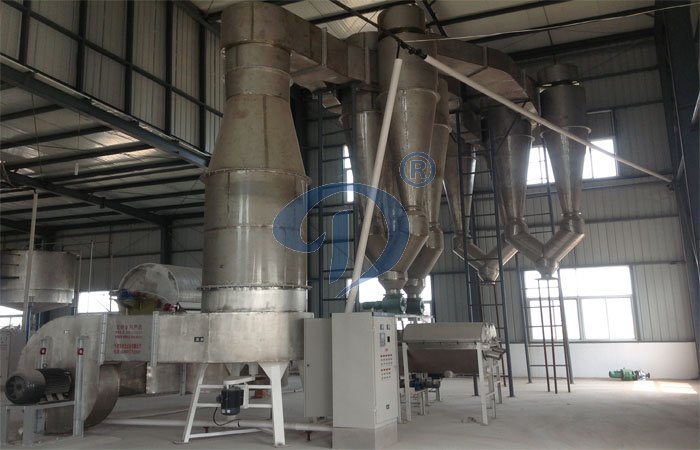 Tel/WhatsApp
Tel/WhatsApp
Wheat starch and gluten manufacturing

Drying machine wheat starch
Wheat Starch and gluten manufacturing is a wet process . One kind wheat starch and gluten manufacturing process called Martin process.
Martin process of wheat starch and gluten manufacturing involves mixing flour and water to make a developed dough . The dough is then washed in a variety of mixing troughs with large amounts of water to get purified gluten and diluted starch milk , which is then concentrated and separated into A and B starch .
Another principal difficulty with wheat starch and gluten manufacturing lies in separating the two because each has very different physical properties. Gluten is awkward to extract from a parent flour because of its rubbery stickiness.
A major factor in any decision to build a wheat starch and gluten manufacturing factory is the market for its products. Such a factory manufactures five main products: "A" (or primary) starch, gluten, "B" (or secondary) starch, solubles and bran . The market must be able to support competitively the profitable disappearance of these goods.
The uses of "A" starch are found foremost in the fine paper and food industries, where low protein maize starch and farina (potato starch) compete. Modified starches can also be derived for either industry. In the fine paper industry, "A" starch is used for sizing. "A" starch also is incorporated in many varieties of food and is used as a feedstock for ethanol production and conversion into glucose syrups. In some countries, "A" starch is sold in wet or slurry form and transported in tankers. This cuts out the need for drying to a powder. Gluten today is sold as a powder, although in the past it was common to trade it in wet form in some countries. "B" starch is marketed in the adhesive and corrugated paper industries, as well as for food. Solubles are marketed in syrup form for ruminants.

Wheat starch and gluten making machine
The input for a wheat starch and gluten manufacturing factory is wheat flour. The nature of the particular wheat flour will vary from location to location depending on wheat variety, quality, price and availability.
Typical yields from a wheat starch process will be between 50% and 54% of "A" starch at less than 0.4% protein, 8% to 12% of gluten at 75% protein, 6% to 10% of "B" starch at less than 1.2% protein and 14% to 20% solubles at up to 4% protein, all expressed on a dry basis. But yields can vary considerably from these examples.
Remember that wheat starch extraction is some five times greater than gluten in wheat starch and gluten manufacturing factory — even though the revenues are roughly equal — and the personnel skills needed are very different from flour milling in certain respects.
All in all, wheat starch and gluten manufacturing is an exciting and fascinating business.Weclome to contact us if you are interested in wheat starch and gluten manufacturing.
-
 Cassava transformation into gari granules facility shipped to Guyana
Cassava transformation into gari granules facility shipped to Guyana
-
 15tph full set cassava chips processing facility was shipped to Laos
15tph full set cassava chips processing facility was shipped to Laos
-
 Cassava mill and garri sieving plant designed for standardized garri production was dispatched to Nigeria
Cassava mill and garri sieving plant designed for standardized garri production was dispatched to Nigeria
-
 How is tapioca flour produced?
How is tapioca flour produced?
-
 How profitable is garri processing?
How profitable is garri processing?
CONTACT US
DOING company offers cassava processing machine from single machine to the complete production line. If you want to get more details about cassava processing machine, please contact us:
- Do you want to buy machine?
- Yes, I want to buy machine
- No, I Just learning
- What is your raw material?
- Cassava
- Potato
- Sweet potato
- Others
- 2. What is the final product you want to produce?
- Garri
- Cassava flour
- Cassava starch
- Cassava chips
- Attiekie
- Bammy
- Others
- 3.What is your capacity plan?
- Small scale garri machine
- 1ton per day
- 2tons per day
- 3tons per day
- 10tons per day
- 20tons per day
- Others
- 3.What is your capacity plan?
- Small scale
- 5tons per day
- 10tons per day
- 20tons per day
- 50tons per day
- 100tons per day
- Others
- 3.What is your capacity plan?
- Small scale
- 5tons per day
- 10tons per day
- 20tons per day
- 50tons per day
- 100tons per day
- 200tons per day
- 300tons per day
- Others
- 3.What is your capacity plan?
- Small scale
- Middle type
- Large scale
- What is your capacity plan?
- Small scale
- 5tons per day
- 10tons per day
- 20tons per day
- 50tons per day
- 100tons per day
- 200tons per day
- 300tons per day
- Others








